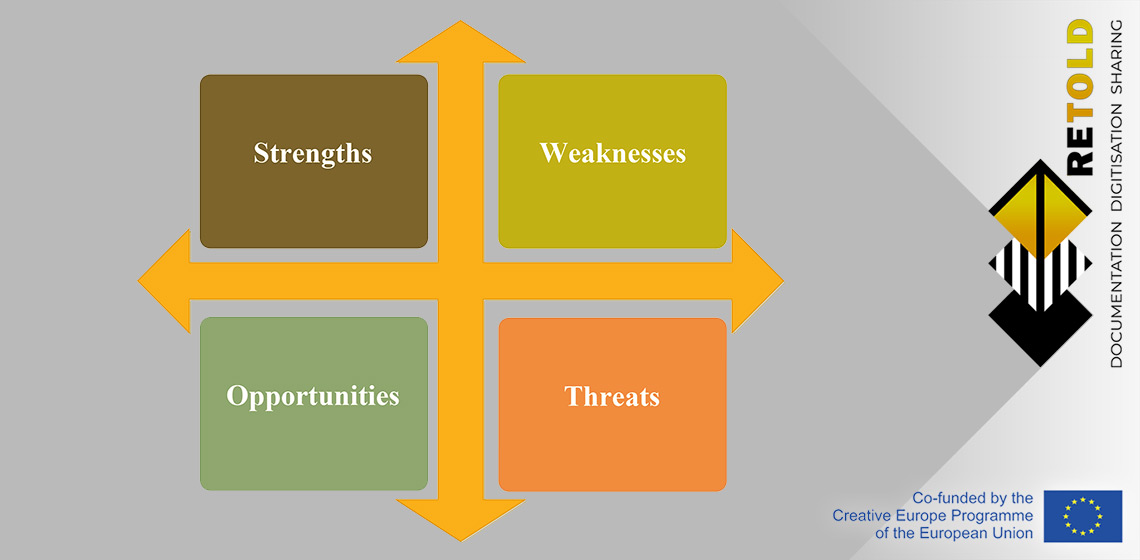The content is published under a Creative Commons Attribution Non-Commercial 4.0 License.
Unreviewed Mixed Matters Article:
RETOLD: A SWOT Analysis

After two years of implementing the RETOLD Project, we made a SWOT Analysis of the current stage of using digital technology in the daily activities of open-air museums, as far as documentation, digitization and sharing heritage are concerned. The analysis was made based on the answers from a questionnaire applied in the three partner museums involved in the projects: Stiftung Stadmuseum Berlin (i.e. Museumsdorf Dueppel) and Steinzeitpark Dithmarschen, both from Germany, and ASTRA Museum from Romania, first at the beginning of the project, then halfway through its development, and it will also be applied at the end. We must outline from the beginning that there are differences between the three museums regarding their profile - two of them are archaeological open-air museums and one is an ethnographic open-air museum - and also as far as their different institutional capacity, given by the size of the institution and number of personnel, is concerned.
After the general information about the responding institutions, a first important chapter of the questionnaire was focused on the documenting strategies within the institutions. Of course there is a documenting strategy, but they are more like internal procedures. The three museums document things from administrative papers to specific activities related to the artifacts, constructions/reconstructions, crafts, and experiments. Halfway through implementing the project we can notice a slight improvement of the degree of satisfaction regarding accurate documentation on recording the specific working stages, with more room for improvement. One of the aims of the RETOLD Project is precisely that; to grow the documentation capacity with the help of the digital instruments created.
Regarding the communication strategy inside the organizations, the most frequently method used is face-to-face dialogue, but also modern means such as e-mail or text messages are increasingly used to transmit information. Communication with the target audience is done through the web pages and on social media platforms. Regarding this issue, there are differences between the museums; in the larger ones there are fulltime employees that manage the social media, while in the small ones this activity is carried out by part-time employees or volunteers.
Use of digital technology is more frequent in the open-air museums as far as internal communication is concerned, like communication with the public and the administrative office. We observed a change during the project development, in that the three institutions involved started to use technology to a wider extent in the documentation field as well, crossing the line of just the classical photo and video documentation. There are two major problems in using digital technology on a large scale: the lack of trained personnel and the lack of financial resources for equipment and software.
The strategy for heritage digitization in the three museums consists mostly of digitizing the collections. It is done in different proportions according to personnel with main tasks in this field. Digitizing the objects is done to create an internal database, by making photos and compiling a file for each object, but also to communicate with the public.
If, until now, the questions from the questionnaire were about the general use of technology in open-air museums, from here on they were focused on the implications that the RETOLD Project has in encouraging use of digital technology in the daily work of open-air museums.
Thus, in the context of the RETOLD Project, digitization makes the documentation of the heritage easier to access for the specialists through the multitude of equipment and digital instruments used, making a database with complete information that is easy to use and share, and accessible for all kinds of beneficiaries worldwide. The main problem we faced is the necessity of trained personnel or the training of current personnel. It is a chance to show that the digital technology is easy to use and can lead to an easier, simpler and more diverse communication about the heritage. Unfortunately, the limited financial resources for purchasing equipment, the possibility of losing data or the necessity of allocating time for these activities can be an obstacle for easily adopting these working techniques that will demonstrate their viability in the long term.
The documentation of the heritage and the creation of a common database to help record all available information will make the work of the specialists easier, but the process and equipment must be accessible, easy to use and applicable to all heritage categories. The project offers the opportunity to create standards for documenting buildings and crafts that can be used on a large scale, creating the possibility to compare data according to various criteria (from raw materials to final products, by geographic region, by historical era, etc.). The main risk is that the open-air museums will not adopt the Project-developed system because of the need to allocate human resources that must enter the data, the prioritization of their other activities, or other more or less subjective factors.
Sharing the existing information from the museums contributes to easy data access, for specialists as well as for the public. Taking every category’s needs into consideration may lead to data being boring or trivial to others, but the chance of discovering other heritage from all over the world can also draw new kinds of public. A main problem can be creating digital storytelling, knowing that not all open-air museums have the capacity to update their content with the new technological resources used mostly by the younger public.
Thus, the RETOLD Project helps the museums to upgrade their documentation, digitizing and sharing their heritage by teaching the partners different methods of using digital technology, providing a complex documentation using easy-to-apply methods that can create new ideas for using digital content in relation to the public. The success of the Project will lie in creating an easy-to-use app for the specialists which is also compatible with the needs of the different categories of public.
Country
- Germany

